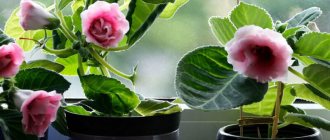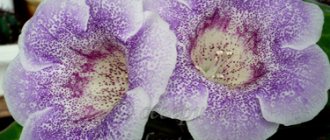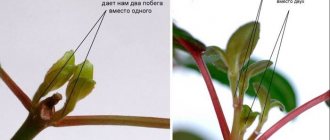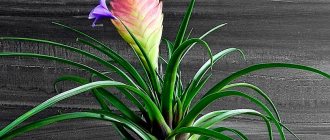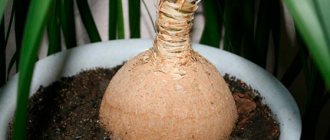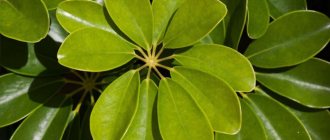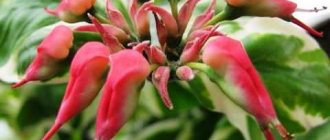Description
Saltirolia is a member of the Nettle family (Urticaceae), a herbaceous groundcover perennial. The genus includes a single species, Soleirolia soleirolii. Previously, the species was classified in the unapproved genus Helxine, hence the outdated synonymous name of the plant - Helksina, or Helksina.
The name was given to Soleirolia in honor of its discoverer - a French navigator, traveler and botanist of the 19th century. Joseph François Soleyrol. Among European peoples, the plant is called “children’s tears”, “tears of an angel”, “mother of thousands”, “Corsican curse”. Peculiar nicknames were given to Soleirolia for the specific shape of leaves and flowers, and the ability to grow in a short time with climbing shoots.
Under natural conditions, Saltirolia grows in the humid forests of Sardinia and Corsica, and is also found in other parts of the Mediterranean region.
The height of the plant in cultivation is up to 5 cm. The creeping stems are flexible and thin, densely branched. The diameter of the round leaves is about 5 mm. Foliage color - lush green, green-golden, lime green, grayish.
IN THE PHOTO: Original leaves of unusual colors are the most decorative part of Soleirolia.
The creamy white flowers of this evergreen perennial are small and inconspicuous. The bracts are covered with clinging, curved hairs. In the middle zone, the flowering of Soleirolia lasts from May to June.
Popular varieties
Aesthetic and popular varieties of Saltirolia in Russia are 'Aurea' ('Gold Queen') with a golden tint of green leaves and the light silvery exquisite 'Argentea' ('Silver Queen'). The decorative form 'Variegata' is decorated with a white border along the edges of the leaves.
IN THE PHOTO: “Golden Queen” of gardens and rock gardens - Soleirolia 'Aurea'.
IN THE PHOTO: Silver-green Soleirolia 'Argentea'.
Comfortable conditions
- table
| Lighting | The plant loves diffused light. Grows well in partial shade. To maintain bright greenery during the winter months, artificial lighting is necessary. |
| Temperature | Temperatures of +20 degrees in summer and +8 degrees in winter are the optimal parameters for plant development; at +5, shoot growth stops. |
| Humidity | The plant loves moisture. In hot summers it is necessary to spray several times a day. In cool weather, moisturize twice a week. |
| Watering | In warm weather, water as the soil dries out. In winter, watering twice a month is sufficient. |
| Fertilizer | Grows better with mineral fertilizers. Fertilizer application algorithm: from spring to early autumn in two weeks. When the plant enters the dormant phase, reduce the amount of feeding by half. |
| Transfer | As soon as the pot becomes too small for a spreading bush, the plants are replanted. |
| Trimming | Pruning is necessary to form a neat shape and remove dried stems. |
| Reproduction | New plants can be grown from seeds, but this is a labor-intensive process. Saltirolia is not afraid of dividing the bush, cutting off shoots from which a full-fledged plant grows. |
In the room, soleirolia is placed in a hanging pot on a high stand - the shoots hang beautifully, forming dense growth. Ground cover properties are used in large pots where tall indoor plants are planted - the delicate leaves will quickly “cover” the entire surface with a green carpet.
Soleirolia greenery looks great next to other indoor flowers.
Important! Saltirolia is often planted on the bare trunks of dracaena, yucca, and palm trees. However, it should be remembered that it is quite aggressive and can strangle its more fragile neighbor.
Saltirolia is perfect for decorating open-type florariums that maintain a humid microclimate.
Saltirolia feels great in the florarium
For reference. Florarium is a plant composition in a glass vessel: a tall glass, a vase, an aquarium. A garden in a bottle, representing a miniature of a tropical rainforest or desert, is created from living plants, moss, pebbles, and driftwood.
Growing
In open ground:
Saltirolia is grown as a green “carpet” in gardens and greenhouses. Since in nature the climbing groundcover grows in rocks and gorges, it is also appropriate in rock gardens. The rich green shoots of Soleirolia on an alpine hill will highlight the beauty of its “neighbors”, which you can read about in the article: “Plants for an alpine hill - mountain flora in your garden.” The plant will decorate a decorative garden path made of large slabs or stones or the shore of an artificial pond.
IN THE PHOTO: A variant of the laconic design of a stone garden path with Soleirolia.
Suitable soil for Saltirolia is neutral (pH 6.0–7.0) or slightly acidic (pH 5.0–6.0). It is undesirable to plant the plant where the soil dries out very much in the heat.
When planting in a garden or flower bed, it is better to choose a place in partial shade or shade for Soleirolia. Being in direct sunlight reduces the decorativeness of the leaves and can destroy the shoots. At the same time, for a healthy look, Saltirolia needs diffused bright light.
Indoors:
Saltirolia in the form of a lush green “ball” is a highly decorative hanging plant that decorates balconies and loggias. It also grows well indoors, including in “winter gardens.”
For growing perennials indoors, a tub with large plants or a spacious container is suitable. The shoots of the plant very quickly spread over the entire surface of the earthen clod and “master” it. Related to this is the need to annually transplant Soleirolia into a shallow, wide container.
The ideal soil composition for indoor or greenhouse Soleirolia is the ratio of chernozem, leaf soil and sand 1:3:1. The soil should be drained, moisture-absorbing and saturated with plant nutrients.
IN THE PHOTO: Soleirolia in a wicker pot-basket is an interesting art object for decorating a garden, patio or loggia with a sufficient level of illumination.
The optimal temperature is 15–22°C. Overheating is more dangerous for Soleirolia than decreasing temperature, especially during the period of forced dormancy (late October - February).
During active growth, in spring and summer, Saltirolia is fed with universal fertilizers for ornamental foliage plants. Specific recommendations for their use are set out in the publication: “Using fertilizers for indoor plants.”
Fertilizing stimulates the already naturally intense growth of Soleirolia greenery. Therefore, it is worth applying fertilizers in half the dose indicated by the manufacturer, once every two weeks.
Errors and their elimination
| Error | Cause | Correction |
| Leaves wilt, they dry out and die. | Moisture deficiency, insufficient air humidity. | Spray daily. Place away from heating devices. |
| Stretching of stems, pale foliage, slow growth. | Insufficient amount of useful elements in the soil, not enough light. | Feed the plant with complex fertilizer. Move to a sunny place, illuminate with a phytolamp. |
| Drying of foliage, appearance of gray-brown spots. | Exposure to direct sunlight. | Move to partial shade. |
| Yellowing and falling leaves. | Excess moisture. | Reduce the number of waterings. |
Reproduction
Bush division:
Saltirolia reproduces by dividing the turf - a green “carpet” formed by shoots. It is divided by hand as soon as the bushes grow. Using a knife to divide Soleirolia turf is not recommended. The divided bushes are immediately transplanted to a new place in the open ground or into containers of suitable size.
Cuttings:
Another way to propagate Saltirolia is by cuttings. Cuttings are separated during the active growing season of the plant. The lower part of the shoot is removed, leaving an oblique cut. Then the cutting is placed in a substrate whose composition is indicated above. The desired container volume for a small-leaved indoor plant is 100 ml.
After this, the cuttings are watered abundantly and kept in conditions of high humidity, at a temperature of 25°C and 12 hours of daylight until rooting. The rooted Soleirolia sprout is placed in a “permanent” container. The first fertilizing to stimulate growth is applied two weeks after transplantation.
IN THE PHOTO: Grown cuttings of indoor Soleirolia.
Diseases and pests
The soleirolia plant is very resistant to harmful insects and diseases. However, if she is not provided with good care and optimal conditions for growth, then problems may arise with her, for example:
- Gray rot . You can tell that a plant is affected by gray rot by the gray fungal coating that forms on the surface of the foliage. As soon as the plaque is detected, you need to immediately cut off all the affected stems, and also reduce the amount of watering and air humidity. If everything is done in a timely manner and correctly, then the flower will not die.
- Brown rot . As a rule, this disease affects the stems, causing them to become thinner and dry out. As soon as the first signs of the disease are noticed, spray the bush with a solution of Rovral, and be sure to follow the instructions. For preventative purposes, it is recommended to promptly cut off all dead foliage and shoots from the bush.
- Whitefly . If a whitefly settles on the soleirolia, you can tell by the curling, yellowing and dying of the leaves. In order to get rid of this pest, the flower is treated with a solution of the fungicidal drug Aktara.
- Spider mite . Drying and dying leaf blades are most often a sure sign that a spider mite has settled on a flower. As soon as the first signs of the presence of the pest are detected, spray the bush with Fitoverm.
- The bush has dried up, can it be saved? Despite the fact that helxinia is a rather capricious plant, it is very tenacious. If, due to an oversight by the gardener, the bush has completely dried out, it can still be saved. To do this, cut off all dried shoots and plant the roots in a new pot and fresh substrate. After just 4 weeks, the bush will again become lush and beautiful, but only if you care for it properly.
Secrets of success
To ensure that the amount of light is sufficient for the formation of a lush and shiny “cap” of Soleirolia leaves, it is not recommended to place the plant on the north side.
Drying of leaves and stems is unsafe for indoor and outdoor Soleirolia. Therefore, you need to constantly moisten its green “carpet” manually or using automatic sprinklers for the garden.
IN THE PHOTO: Regular spraying preserves the beautiful color and turgor of Soleirolia leaves.
Saltirolia is moisture-loving, needs regular, abundant watering, but seriously suffers from stagnation of water in the soil. Excess moisture should be drained from the container with the plant.
Diseases
Saltirolia gets sick most often due to violation of the rules of caring for it during cultivation.
- If the stems begin to turn yellow and dry out, the flower does not have enough moisture. Water the plant more often and abundantly, especially in the summer.
- If individual shoots or entire sections of the bush on the window side turn yellow, this may be due to sunburn. Protect your pet from direct sunlight and place the pot at the back of the room.
- If Saltirolia began to lose its decorative effect, the shoots began to stretch out and become bare, which means that the flower does not have enough lighting. Place the pot closer to the light or arrange additional lighting when necessary (with a phyto lamp, for example).
- If one side of the plant is thick and lush, and on the other side the leaves are not so dense and beautiful, turn the pot from time to time with different sides towards the light. Then it will be evenly illuminated and look great from all sides.
- If the leaves of the plant begin to dry out, wrinkle and fall off, it means you are not watering it enough, or the air in the room is very dry and hot.
- If yellowed leaves begin to wither and fall off, you should think about root rot. The reason may be too wet soil, prolonged stagnation of water in the pan - the root system does not have enough oxygen. The roots become wet, rot and die. Remove the bush from the pot and inspect the root system. Cut off the rotten sections of the roots, treat the rest in potassium permanganate or phytosporin, dry, sprinkle with crushed activated carbon and plant in new, loose, nutritious soil. If the disease is advanced, it is better to destroy the flower. Don't be discouraged; if you want, you can quickly grow a new flower with the help of healthy shoots.
- If you follow all the rules of care, but the bush grows poorly and looks faded, you may have planted it in insufficiently nutritious soil. Try feeding Soleirolia with liquid fertilizer for decorative foliage plants. The result will surprise you.
- If gray rot appears on the leaves, it means that the air humidity is too high at a low temperature. It is necessary to remove the affected leaves, reduce watering and reduce the air humidity in the room. Ventilate the room. Stop spraying the flower. Adjust the temperature.
- If the plant stem has become thin and brown, your flower has been attacked by brown rot. The reason for its occurrence lies in the structure of Soleirolia: fallen leaves, density and low height of the plant are an excellent habitat and development of the mycelium. Spray the diseased plant with Rovral fungicide or similar. To prevent the disease, monitor the condition of the plant’s green mass, remove dead and damaged leaves and shoots, and do not allow water to stagnate in the pot.
This may be interesting: How to grow Cyperus (Papyrus) at home
With proper care, Soleirolia will become a real decoration for every corner of your home, giving its inhabitants a good mood and peace.
2.Caring for saltwater at home
Divide your indoor plant into small pieces when repotting. Stem cuttings.
2.2.How to replant soleirolia
Replant in the spring when the soleirolia outgrows its pot. To plant saltirolia, choose a wide, shallow pot with large drainage holes.
2.3.Soil
Nutritious, with sufficient organic matter, constantly moist but well drained, containing a large amount of peat and moss.
2.5.Diseases and pests
Among the diseases, the development of root rot is possible due to waterlogging and stagnation of water in the pan. The shoots become bare and the foliage turns yellow due to uneven watering.
Of the insect pests, saltirolium is attacked by whiteflies and aphids, and spider mites.
Insects - pests
| Insect name | Signs of infection | Control measures |
| Whitefly | Small light spots on leaf blades, yellowing and falling leaves. Disturbed white, small butterflies fly up from the surface of the leaves | Chemicals: Zeta, Rovikurt, INTA-VIR, Fufanol and even Karbofos, Aktellik, Aktara, Confidor, Commander, Tanrek. Folk remedies: soap solution, garlic solution, yarrow and tobacco infusion, dandelion infusion, sticky traps for adult insects |
| Spider mite | Inconspicuous cobwebs on the leaves, yellowing and falling leaves with extensive damage. The surface of the leaf plates becomes dead and covered with small cracks. Plant development slows down. | Folk methods. Plants can be washed in the shower and left in the bathroom in a humid atmosphere for half an hour. Irradiation with an ultraviolet lamp every week for 2 minutes. Chemical preparations based on pyrethrum, sulfur powders, Fitoverm, Actellik. |
| Aphid | Sticky droplets appear on the leaf blades, the leaf blades curl and become deformed, tender buds and young leaves wither. Colonies of insects can be seen on the tips of shoots, buds or the underside of leaf blades. The flowers of plants affected by aphids may become deformed. | Folk methods: nettle infusion, decoction of rhubarb leaves, wormwood, soap solution, infusion of tobacco and dandelion, onion, marigold, yarrow, tansy, dusting with virgin ash. Chemicals: Sulfur powders, treatment of green mass with green potassium soap without getting into the ground, Decis, Actellik, Fitoverm. |
- Whitefly
- Spider mite
- Aphid
2.6.Irrigation of saltwater
The plant loves high humidity. Water deeply and often in the summer, but reduce watering in the winter (keep the soil slightly moist).
2.7.Care, pruning
An attractive plant that puts forward its own requirements for maintenance. It does not tolerate direct sunlight, high temperatures, dry or waterlogged soil with poor drainage. Shoots hanging over the edge of the pot do not grow much in length, since they need contact with the ground. Trim the gelxina with scissors at any convenient time to maintain a neat, compact shape.
2.8.Containment temperature
Prefers moderately warm conditions with daytime temperatures in the region of 16 - 20 ° C, at night - 10 - 14 ° C. Does not tolerate frosts.
2.9.Lighting
Feels comfortable in the shade, but prefers bright, reflected light. Direct sunlight can cause burns on the leaves.
2.11.Spraying saltrolia
Requires moist air, periodically spray with soft water at room temperature. Plants require well-ventilated rooms with constant air movement, but without cold drafts.
2.12.Purpose
A beautiful ground cover that looks great when planted under tall potted plants or in hanging baskets. Saltirolia is often grown in florariums and bottle gardens.
Note.
Hydroponics.
You might also be interested in:
Replanting soleirolia
The plant needs to be replanted every spring. The pots for the plant are not high, but wide enough. The soil used is loose and retains moisture.
It is very important not to press down the ground when replanting a bush. Everything must be done to ensure that the roots are fed with oxygen.
Applying fertilizers to the soil
If the plant is not enriched with fertilizers, then it needs to be replanted every year or two. Fertilizers are introduced into the soil in the warm season, usually March and September.
Fertilizers add juiciness and bushiness to the greens. Feeding is carried out every two weeks. To do this, you need to use a complex of fertilizers designed for better development of the bush.
Saltirolia: care at home
Many gardeners believe that the plant is very finicky and caring for it will be too troublesome. Yes, soleirolia will not grow in ordinary apartment conditions; it needs special conditions. But it cannot be called very complex or greenhouse.
Note! Decorative nettle has fragile roots and shoots, but despite this, the plant is very resistant to sudden temperature changes and is not afraid of drafts. It can recover after a complete drought
Conditions of detention:
the temperature in summer should not exceed 25 °C, optimally 20 °C
In winter 15-20 °C; lighting should be maximum, but diffused, as soft leaves can get burned; Watering on hot days is plentiful; it is important to ensure that the soil is always moist. The roots are thin and rot easily if there is water in the tray or the pot does not have good drainage
A signal that there is too much stagnant moisture in the soil is rotting and turning brown leaves at the base of the stems; The humidity should be tropical. On hot summer days, you need to spray the flower three times a day, then the juicy and thick greenery will be a gratitude in return. In winter, spray once a week. If the plant's humidity is low, its leaves will fall off and the tips of its stems will dry out; feeding continues from the beginning of active growth until September. The usual complex composition is suitable no more than twice a month.
Important! Fertilizing during annual soil renewal is not necessary
Winter care
Since lighting and humidity drop sharply, the flower stems often become elongated, the leaves do not grow densely and lose their color saturation. If you give the plant a period of rest, it will perfectly retain its decorative appearance. When the temperature drops, a transition to sleep mode occurs, growth stops, and the flower does not require frequent watering, spraying and abundant lighting.
Note! A sleeping plant can be placed in shade or partial shade.
It is important during this period to reduce the temperature to 12-15 ° C and maintain it without fluctuations. An increase to 20 ° C will awaken the plant after hibernation and it will begin to grow, and this requires light and humidity
Reducing the temperature to 8 °C will completely destroy the flower without the possibility of recovery
An increase to 20 °C will awaken the plant after hibernation and it will begin to grow, and this requires light and humidity. Reducing the temperature to 8 °C will completely destroy the flower without the possibility of recovery
It is important during this period to reduce the temperature to 12-15 ° C and maintain it without fluctuations. An increase to 20 ° C will awaken the plant after hibernation and it will begin to grow, and this requires light and humidity
Reducing the temperature to 8 °C will completely destroy the flower without the possibility of recovery.
Saltirolia is a houseplant that does not feel very comfortable in winter.
If it is not possible to adjust the temperature regime for hibernation, you need to take into account several nuances of wintering:
- for the growth of dense stems, additional artificial lighting is needed;
- if the flower is standing next to heating devices, the air will be dry, which has a detrimental effect on the appearance of the flower. To increase humidity, you need to place containers of water next to the soleirolia pot;
- if active growth is observed, you can feed it once a month with complex fertilizer.
The awakening period for nettles is late February, early March. During this period, the plant is pruned, replanted, placed in a sunny place and fertilizing begins. In early spring, with proper care, it can even bloom. Although its flowering does not present a colorful picture, this fact serves as a sign of the flower’s comfortable living conditions.
Trimming
The bush loses its decorative effect after 2-3 years of growth in the same pot, so it is often completely renewed. If soleirolia is adjacent to a larger plant in a pot, its decorative appearance can be saved after wintering by pruning.
For your information! By forming short shoots and removing long and bare shoots after wintering, you can get a green ball. Pruning does not injure the plant at all and does not require additional processing of the cuts.
During replanting, it is also recommended to trim shoots that are too long so as not to deplete them during adaptation to the new soil.
Varieties
In the genus soleirolia (gelxins), the only species recorded is Soleirolia soleirolii . Its bright green leaves with a shiny surface are most common. To diversify the assortment at least a little, breeders have developed several decorative varieties of soleirolia:
- argentea – distinguished by silvery leaves;
Helxina argentea - variegata – leaves have a thin snow-white border;
Gelksina variegate - aurea - has yellowish or golden foliage.
Helxina aurea
All varietal differences appear in bright light, otherwise the plant takes on its original emerald appearance.
